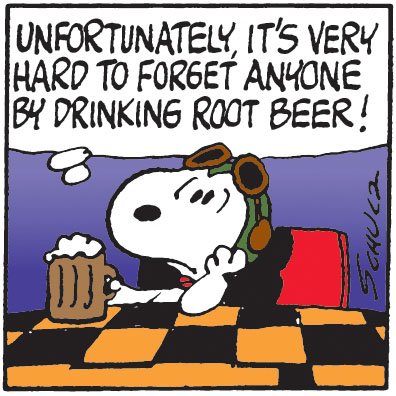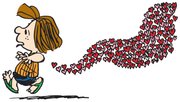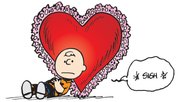"There's something funny about unrequited love -- I suppose it's because we can all identify with it." -- Charles M. Schulz
For being one of the world's most beloved comics -- bringing joy and warmth to millions -- "Peanuts" has a fair amount of serious topics: Loneliness, unrequited love, a search for meaning... But even those motifs are funny -- and perhaps make the strips loved even more -- because it's small children and one sassy dog delivering the lines.
FAQ
‘Heartbreak in Peanuts’
WHEN — Wednesday through April 16; opening reception on Tuesday
WHERE — Fort Smith Regional Art Museum
COST — Free; reception is $25/$20 for members
INFO — 784-2787 or fsram.org
BONUS — “Heartbreak” will have a special Valentine’s Day opening reception from 5 to 8 p.m. Tuesday with live jazz, themed cocktails, light hor d’oeuvres and giveaways. Admission is $25 for nonmembers.
"I think it's important to note that Schulz didn't intend to write the 'Peanuts' strip for children," says Cesar Gallegos, archivist at the Charles M. Schulz Museum in Santa Rosa, Calif. "But I think using the kids as a vehicle, it allowed him to play with different themes, because if it was an adult saying some of these things, it would be a little more heavy."
"Heartbreak in 'Peanuts'" is a traveling exhibition from the museum that explores one such topic. With love -- specifically of the unrequited variety -- being such a major theme throughout "Peanuts," museum staff wanted to put together an exhibition representing some of the most prominent storylines: Schroeder's preference for Beethoven over Lucy, Sally's adulation of her Sweet Babboo Linus, Charlie Brown's pining for the Little Red-Haired Girl. Most everyone can relate to the feeling of wanting someone who doesn't want them back. But look at the situation through the nostalgia-tinted words of a "Peanuts" strip, and it becomes a little less painful, a little more endearing.
"It's something more so about Schulz and his ability to touch on something that's really genuine about humanity, and love is something that's a connective thread throughout the world," Gallegos says. "Love is something that people interpret and experience -- it's universal. So with these themes, people are going to be able to relate to them, and in that sense they are able to relate to each other. It's a really neat thing."
"I'm not your Sweet Babboo!" -- Linus van Pelt
For "Heartbreak in 'Peanuts,'" as with most of their exhibitions on the comic, the staff at the Charles M. Schulz Museum decide on a theme and then sort through nearly 18,000 strips -- close to 50 years of art -- choosing the best sequences or one-off panels to convey the idea. Next a former secretary to Mr. Schulz and his widow Jean will view the selected works and provide insight from that period of his life -- context for the exhibition text.
"There's an example of 'Sweet Babboo' that Sally calls Linus as a term of endearment -- it actually came from Jean Schulz calling Mr. Schulz Sweet Babboo, so he put that into the strip," Gallegos says. "Every exhibition we do starts with Schulz as the focus. What we try to do is introduce Schulz to the audience so people learn about his life, but they learn also about the 'Peanuts' characters and the 'Peanuts' strip along the way. But the center is always Schulz."
Guests to the museum or an exhibition are often seeing Schulz's work at its original size for the first time. Printed small in newspapers and most curated books, the panels in the exhibition are 6 inches to 7.5 inches by up to 28 inches, offering viewers a whole new perspective. Gallegos says one of his great joys working with the museum, though, is witnessing that moment of realization in visitors when they learn of the little pieces of Schulz he put into his work.
"He would always say, 'To read the strip is to know me.' More than anything, it adds to his art and his life."
"I think I'll come right out and tell that little red-haired girl that I love her ... Then I'll give her a big hug ... Then I'll go bungee-jumping from the moon." -- Charlie Brown
Gallegos suggests it is the capacity for interpretation that has contributed to the "Peanuts'" staying power. There are people who relate to Sally, or to Lucy, or to Charlie or even to Snoopy, and as they grow and experience new things, their interpretations of the comic change. He says it is likely the unrequited love, or Charlie Brown's feelings of inadequacy, that adults will relate to in "Heartbreak," while the anticipation of hoping to receive a Valentine, or the physical comedy in waiting by the actual mailbox may resonate more with a younger generation. But even after a lifetime of keeping up with "Peanuts," there are often things fans have forgotten or never realized before, which can lend a sense of surprise to a new exhibition.
"A lot of people say they read [the comic] completely different from the way they read it as a child when it first came out. So the jokes work on [various] levels, which is really fascinating and speaks [to] just how brilliant [Schulz] was in terms of storytelling and writing," Gallegos says. And for every panel showing a depressed Charlie Brown, or Lucy putting him down, or one of the children being rejected, there is still a sense of hope and joy surrounding these beloved characters.
"Love and relationships ... [don't] always go the way you want it to go. But that doesn't stop Charlie Brown from continuing to live his life and be who he wants to be. ['Heartbreak in Peanuts'] says a lot about perseverance as well. Just as Charlie Brown loses most of his baseball games, that doesn't mean he puts down his mitt and his baseball bat; he keeps going. And it's the same thing [as] him and romance and still waiting by the mailbox to get Valentine cards -- it's that perseverance and not giving up."
NAN What's Up on 02/10/2017




